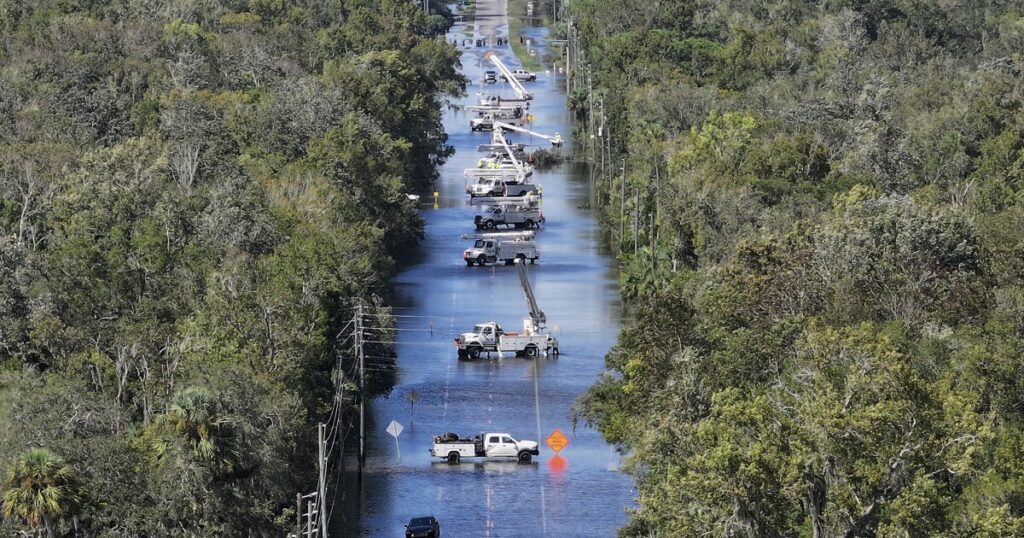Helene leaves US South reeling from flooding and power outages

Enjoy complimentary access to top ideas and insights — selected by our editors.
(Bloomberg) –Rescue missions are underway across the US South as the region reels from historic flooding caused by Hurricane Helene, which has killed at least 52 people and knocked out power to millions, putting stress on aging dams and leaving behind potential losses of more than $100 billion.
Water rescues were reported Saturday in northern Tennessee and in North Carolina, which saw nearly 31 inches (79 cm) of rainfall from Helene in some places, according to the Weather Prediction Center — the current maximum recorded anywhere. Search and rescue teams from 19 other states have deployed to North Carolina, so far helping to rescue more than 200 people from Helene’s floodwaters.
“This is a historic and catastrophic storm for Western North Carolina and I’m grateful to first responders working right now to save lives and evacuate residents,” Governor Roy Cooper said in a statement. “Efforts are also underway to get power and communications restored, and we’re bringing in needed supplies by air.”
From Indiana to Florida, more than 3.2 million customers are without power with South Carolina accounting for about 31%, according to PowerOutage.us.
The remnants of Helene, which made landfall as a Category 4 storm in Florida, were last tracked about 135 miles west-southwest of Louisville, Kentucky, early Saturday as they were being absorbed into a larger weather pattern.
Read more: Deadly Hurricane Helene’s Flooding Started Days Before Landfall
Though parts of North Carolina were hit especially hard, the larger area across Georgia and South Carolina also got anywhere from 11 inches to 14 inches (28-36 cm) of rain before Helene dissipated, Brian Hurley, a senior branch forecaster with the US Weather Prediction Center, said in an interview.
It has been more than 100 years since the region was hit by flooding this severe, Hurley said. “For some of those areas you have to go back, no doubt, over 100 years, for some it could be into the 300-year range.”
Little additional rain is forecast, which will allow rescuers to save residents and give rivers, streams and dams a chance to slowly recover from the storm, which came ashore in the Big Bend area of Florida late Thursday. Advisories and flash-flood warnings are still scattered throughout the South as rivers take on additional runoff from the recent extreme rains.
Helene is the deadliest hurricane to hit the US mainland since Ian struck Florida in 2022, killing at least 150 and causing $122 billion in damages and losses. Across the South, as many as 52 people have been killed by Helene, the Associated Press reported.
In addition, the storm may be one of the costliest. Flooding and destruction wrought by Helene may total between $95 billion to $110 billion, commercial forecaster AccuWeather Inc. estimated, which would easily place it among the top five worst hurricanes to hit the US.
Read More: Helene Dumps Rain on Millions of Homes That Lack Flood Insurance
President Joe Biden on Saturday approved an emergency declaration for Tennessee, having done so earlier in the week for South Carolina, North Carolina, Alabama, Georgia and Florida.
Widespread damages have been reported, with water flowing through the streets of many cities and towns, snarling transportation. Parts of Interstate 40, a major east-west highway, have been washed out, as have parts of Interstate 26, which runs north-south.
“All roads in Western N.C. should be considered closed,” the state’s department of transportation said in a post on X Saturday afternoon. “Travel in this area for non-emergency purposes is hindering needed emergency response.”
Listen on Zero: Climate Change Is ‘Loading the Weather Dice Against Us’
Lake Lure dam in North Carolina, where scenes from Dirty Dancing were filmed, was overtopped and officials feared it might fail. Residents living on streets below the dam were ordered to leave their homes and shelters were set up nearby, according to the town’s website. Engineers performed an inspection and declared the structure was safe late Friday.
Many other dams throughout the region are also under stress. Officials in eastern Tennessee ordered evacuations near the Nolichucky Dam, which was at risk of a breach early Saturday morning. Water levels finally peaked at 9.5 feet (3 meters) above record height before beginning to recede Saturday morning, said Elisabeth Thompson, a senior strategic consultant for the Tennessee Valley Authority.
“Our dam safety personnel are continuing to conduct inspections,” Thompson said, “and they’re waiting for water to continue to recede before doing additional inspections. But from everything we can tell, we’re in good shape.”
Meanwhile, Tropical Storm Joyce and Hurricane Isaac are churning in the central Atlantic and currently aren’t a threat to land. There are two more storms that may develop next week, one near Cabo Verde off Africa and another in the Western Caribbean close to where Helene originated.


